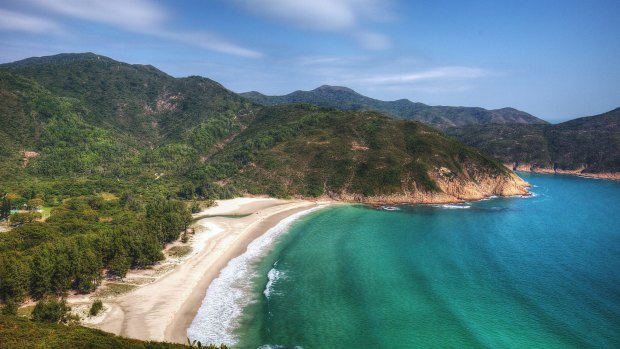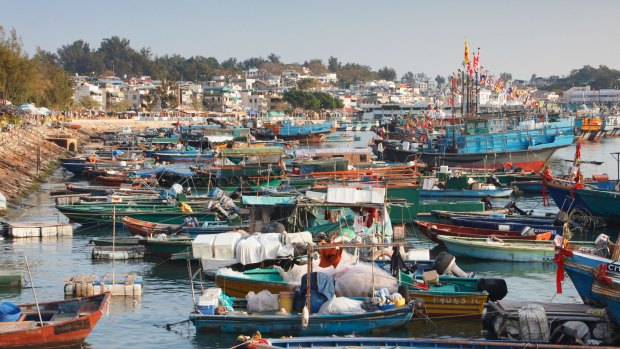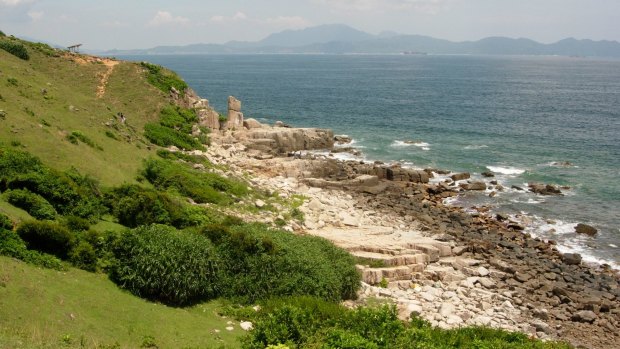This was published 7 years ago
Hong Kong day trips to lesser-known islands: Island hopping like a local

Serene sands on Long Ke beach.Credit: Getty Images
I'm standing near a serene grassy cliff face, dotted with the igloo-shaped tents of a host of happy campers in the company, oddly enough, of diminutive feral, though tame cows, overlooking a jagged coastline and a series of scattered islands and islets.
It could be the sort of breathtaking panorama more commonly encountered on the coastlines of countries like the Philippines or Vietnam or Malaysia, or a handful of other South China Sea-bordering places that ring what's emerged as one of the most contested stretches of water on the planet.
But, no, this is Tap Mun Chau, or, aptly, in English, Grass Island, a mere 45 minutes from frenetic Kowloon (or an hour if you add the 15 minutes or so by ferry that it takes to finally reach the island). Despite its remarkable proximity to one of Asia's busiest and most populated cities, Tap Mun really couldn't feel more remote.

Boats In Cheng Chau Bay, Hong Kong. Credit: Ian Trower - Alamy
It lies near Sai Kung, a "town", with roughly the population of Canberra, in Hong Kong's northernmost New Territories region. Sai Kung has been dubbed "Hong Kong's back garden", due to its idyllic hiking trails, beaches and islands. It has become a favoured destination for Hong Kongers and expats alike in search of respite from the rat race of Kowloon and Victoria.
For visitors like me, it's that rat race, and all of its resulting liveliness and cosmopolitanism, that remains the appeal for a holiday in Hong Kong. But it's also a genuine delight to discover an aspect of Hong Kong's invariably overlooked quieter side.
Ever since I started visiting Hong Kong, two decades or more ago, I've tried, whenever possible, to devote a day trip, and even the odd overnight jaunt, to its outlying islands. Most tourists who venture beyond Kowloon and Victoria head, as I've done in the past, to the more easily reached Hong Kong islands such as Cheng Chau, Peng Chau, Lamma and Tai-o.

The islands have long charmed visitors.Credit: Getty Images
But on this visit I was determined to discover some lesser known day trip destinations, though it seems that Tap Mun is no real secret to locals. The ferry to the island is brimful of merry Hong Kong day-trippers, families, hikers, and campers with only a lone gwai lo (meaning white devil or ghost person) aboard.
The ferry deposits me and Yammy, my local Hong Kong guide for the day, at the Tap Mun pier where to one side of the wharf is a collection of pontoons from where you can pay to fish for a few hours or longer. The pier leads to the island's tiny fishing village full of basic though inviting seafood restaurants as well as a sprinkle of street stalls staffed by sun-kissed middle-aged women in traditional conical hats, a far cry from the fashion and label conscious dames of Central, the Rodeo Drive of Hong Kong, on Victoria.
Before heading up a hill to that grassy cliff face we pass an abandoned school and the 400-year old Tin Hau Temple, preferring to push on so we can sample the view from the cliff face in the midmorning light (if you've seen one 400-year old temple...) It's an easy stroll to the cliff, though beyond there the track to other parts of Tap Mun is poorly marked.
Later, we manage to make it to what appears to be the highest point on the island, topped by a telecommunications tower. We decide to head back to the cliff face, where tourists are picnicking under pavilions, with hopeful and hungry bovines in attendance, passing hikers along the way who, unlike us, are able to devote a whole day to Tap Mun.
From there, we return to the pier to take the ferry back to the mainland, the boat making a brief stop at another fishing village, Ko Lau Wan. This looks like an island but is actually part of the mainland Sai Kung Peninsula. A couple of young female campers from back at the cliff at Tap Mun Chau, are disembarking here for a hike.
You can take a bus to Sai Kung but we splurge on a taxi, as we have a lunch reservation. It's a Sunday and one of Sai Kung's most popular attractions is an array of packed al fresco waterfront seafood restaurants. But we're heading away from the hubbub to a side street to eat at Loaf On, a Cantonese restaurant. It is one of the town's two Michelin-starred restaurants, specialising in Sai Kung's fine local seafood.
The latest Hong Kong Michelin Guide has just been released but we have little trouble securing a table at the restaurant. However, our waiter at Loaf On is a bit glum, saying the staff are worried that the building's landlord is scheming to raise the rent (a regrettable practice in Hong Kong) due to its Michelin star power.
After lunch and an excellent flat white at The Little Cove Cafe, just across the road from Loaf On, we head back down to the Sai Kai pier, battling the pleasure-seeking crowds thronging the waterfront. The pier complex is ringed by fishmongers who operate from boats at water level with all manner of seafood neatly arranged in water-filled buckets and trays displayed to prospective customers above.
We watch as one buyer chooses a fish with the monger then raising a fishing net in which the cash is placed. The money is then taken by the monger with the purchase placed in the net which is hoisted to the customer with the change to follow. Back at Loaf On, the waiter had pooh-poohed both the quality of the fish, and the honesty of the mongers but I, and my fellow day-trippers, find the entire process and system fascinating, if not ingenious.
Next, we buy a ticket from one of the many open-air ticket counters for a traditional wooden sampan ride with a retired fisherman as skipper to Sharp Island, or Kiu Tsui Chau in Chinese, off the coast of Sai Kung. From the island, less than a half-hour away, I gaze back at the coast. It's a cliched Chinese painting of silhouetted, receding mountains layered over one another, ruined only by the outline of towering Hong Kong apartment blocks, like a row of crooked teeth on the horizon.
For those able to linger, this densely vegetated island, part of Hong Kong's UNESCO-listed Global Geopark, is a haven for hikers. And one of the island's beaches, Hap Mun Bay (also known as Half Moon Bay) regularly tops the water quality ratings for Hong Kong. There's also a quite spectacular tombolo, a slender spit or sandbar, too, which temporarily connects it with an adjacent tiny islet.
As the tide rises some day-trippers, who have spent too long on the smaller island, are having to wade through the rapidly rising waters to reach what remains of the sand bar link to the main island.
As we make our way back from tombolo to beach, I am reminded that Hong Kongers, like their Chinese cousins, can't help likening natural formations to food. The tombolo is festooned with boulders that are said to resemble pineapple buns, a popular local snack. As I stand here, yet again, as was the case on Tap Mun, I'm the lone Caucasian tourist among the frolicking day-trippers. It's almost too hard to conceive that the rat race (and the real pineapple buns) of Kowloon and Victoria is just a 45-minute taxi ride over those coastal peaks.
TRIP NOTES
MORE
FLY
Cathay Pacific operates more than 70 flights a week to Hong Kong from six major Australian cities. The are four flights daily from Sydney and three daily from Melbourne. See cathaypacific.com.au
EXPLORE
It's possible to take a taxi, at some expense, all the way from central Hong Kong to Tap Mun and Sai Kung. However, the Hong Kong Tourism Board also has detailed instructions on how to get there by reliable public transport (trains, buses and ferries). The Hong Kong Tourism Board is conducting guided hiking tours of Sharp Island until March 26, 2017, on selected Saturdays and Sundays, except public holidays.
STAY
Most visitors to Hong Kong's outlying islands visit as day-trippers though there is a variety of accommodation in and around Sai Kung. Three of the best hotels in Kowloon and Victoria are The Peninsula, Salisbury Road, Kowloon, doubles from $870, see hongkong.peninsula.com; The Mandarin Oriental Hong Kong, 5 Connaught Road, Hong Kong, doubles from $728, see mandarinoriental.com; 15 Queen's Road, Central, Hong Kong, doubles from $743, see mandarinoriental.com
Anthony Dennis was a guest of the Hong Kong Tourism Board and Cathay Pacific.
FIVE MORE HONG KONG ISLANDS TO VISIT
CHENG CHAU
Popular, car-free and easily accessed, Cheng Chau has long charmed day-trippers with its array of shops, restaurants and beaches. You can even visit the cave hideout of a notorious 19th-century Chinese pirate.
LAMMA ISLAND
Laid-back Lamma is a bohemian blend of east and west and a popular place for expats to live. The easiest outlying island to reach from Hong Kong, there are plenty of places to eat and drink as well as nature to explore.
LANTAU ISLAND
Hong Kong's largest outlying island is home not only to Hong Kong's outstanding airport but also a giant bronze Buddha statue, Hong Kong Disneyland, beaches, forests and hiking trails.
PENG CHAU
Tiny Peng Chau was once home to Hong Kong's thriving lime and matchsticks industry. Now only ruins remain. The island, full of shrines and temples, is reverting to its original quiet rural existence.
TAI O
A fishing village on a tiny island off the western coast of Lantau, Tai O features a fascinating community of stilt houses, some excellent restaurants and the imposing Tai O Heritage Hotel, dating to 1902.
Sign up for the Traveller Deals newsletter
Get exclusive travel deals delivered straight to your inbox. Sign up now.